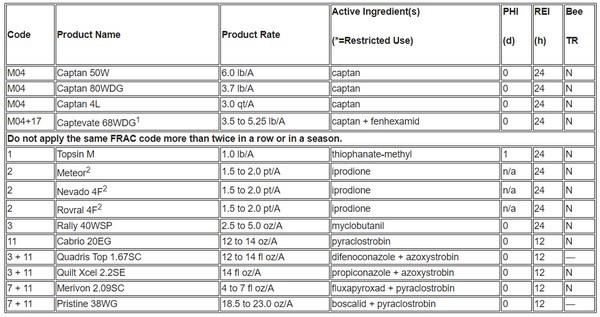Strawberry leaf spot, caused by the soil-borne fungal pathogen, Mycosphaerella fragariae, can infect leaves, petioles, runners, fruit stalks (pedicels), and berry caps or calyxes. Small, dark purple to reddish-purple, round spots, 1/8 to 1/4 inch in diameter (3 to 6 millimeters), appear on the upper leaf surfaces. The center of the spots soon becomes tan or gray and eventually almost white, while the broad margins remain dark purple. Later in the season, dark specks (sclerotia and/or perithecia) may be seen in the older lesions. Tannish areas form on the undersides of infected leaves. The symptoms on the other plant parts, except the fruit, are almost identical to those that develop on the upper leaf surface.
Microsclerotia and conidia from infected leaves that survive the winter can lead to infections of new growth in the spring. The period between infection and the appearance of lesions on the upper leaf surface can range from 10 to 14 days depending on weather conditions. Large numbers of conidia can cause secondary infections during prolonged periods of damp to wet, moderately warm weather. Temperatures between 65 and 75 F (18 to 24 C) are optimal for the growth of fungus and for lesion development. Infections can continue to occur throughout the growing season. Young, expanding leaves are much more susceptible to infection than mature leaves. If frequent rains occur during early- and mid-spring, a few infection sites can start an epidemic.
Control of strawberry leaf spot begins with recognizing symptoms and preventative fungicide applications. All strawberry fields need to be scouted on a regular basis. Especially, during periods of wet weather or during heavy use of overhead irrigation. Weekly applications rotating the following should be done as long as symptoms are present and weather conducive for disease development persists. For more information please see the 2024/2025 Mid-Atlantic Commercial Vegetable Recommendations Guide. Fungicide applications for strawberry leaf spot will be effective for strawberry leaf scorch and strawberry leaf blight.

For organic strawberry growers, weekly applications of an OMRI-approved copper or potassium bicarbonate have been shown to be effective in mitigating strawberry leaf spot.
Source: plant-pest-advisory.rutgers.edu
